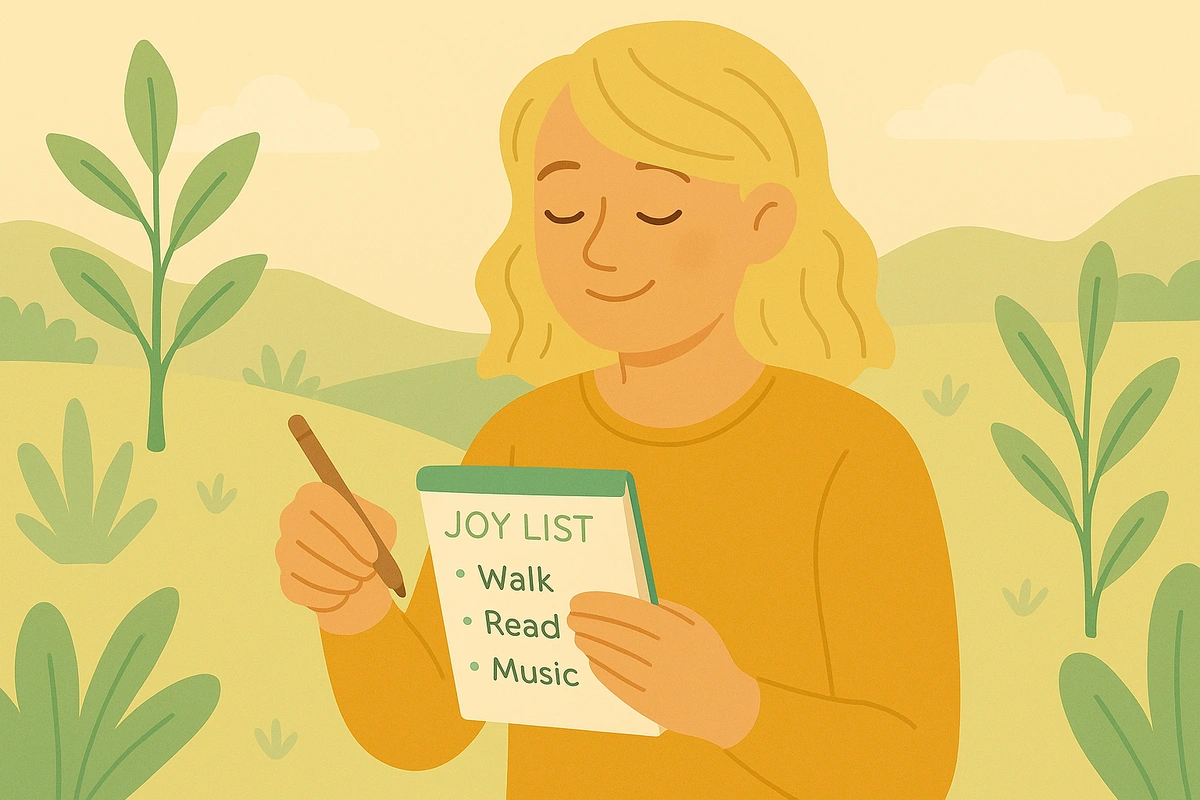Creating a personalized joy list is a simple yet powerful mood management technique that transforms low motivation and negative emotions into reliable moments of pleasure and emotional stability by using your brain's natural reward system.

The joy list exercise involves creating and regularly using a personalized collection of small, immediately accessible activities that reliably boost your mood and motivation. This simple but powerful technique helps you actively counteract symptoms of depression and anxiety through brief, intentional actions that activate your brain's natural reward pathways.
Your brain is naturally wired to seek rewarding experiences through dopamine, known as the "feel-good" hormone that plays crucial roles in motivation, mood, attention and more. Think of dopamine like your brain's internal reward notification system - it signals when something feels good and motivates you to repeat that experience. When you're struggling with low mood or motivation, this system often needs intentional activation through small, meaningful activities rather than waiting for motivation to strike naturally.
The joy list exercise works by deliberately activating your brain's reward system through accessible positive experiences. Dopamine is part of your reward system. This system is designed, from an evolutionary standpoint, to reward you when you're doing the things you need to do to survive. When you engage in activities from your joy list, you're essentially giving your brain the signal that good things are happening, which naturally improves mood and motivation.
Think of your brain's reward system like a garden that needs regular watering. When you're depressed or anxious, this system often becomes dormant - like a garden during drought. Joy list activities are like small, frequent waterings that help your emotional garden bloom again. Dopamine affects how brain decides whether a goal is worth the effort, so when you regularly engage in rewarding activities, your brain becomes more willing to pursue other positive goals.
The technique also works by breaking the cycle of behavioral inactivity that maintains depression. When we are depressed we become less active. The less active we are the fewer opportunities there are for positive and rewarding things to happen to us. Joy list activities provide structured opportunities for positive experiences even when motivation is low.
Research in behavioral activation - a well-established depression treatment - shows that increasing participation in pleasant activities effectively reduces depressive symptoms. Your joy list essentially creates a personalized behavioral activation toolkit that you can use independently whenever needed.
The mindful engagement component amplifies these benefits by enhancing your attention to positive experiences. Mindfulness meditation interventions - which train skills in monitoring present-moment experiences with a lens of acceptance - have shown promise for increasing positive emotions. When you fully focus on your joy list activities rather than multitasking, you maximize their mood-boosting impact.
"Nothing on my list feels appealing when I'm really depressed" - This is normal and reflects how depression affects your reward system. Start with the smallest, easiest activity rather than what seems most appealing. Low levels of dopamine can make you feel tired, moody, unmotivated, but even small positive actions can help restart this system.
"I feel guilty taking time for myself" - Remember that taking care of your emotional needs isn't selfish - it's necessary maintenance that helps you be more present and helpful to others. Just like putting on your own oxygen mask first, emotional self-care enables you to care for others more effectively.
"My joy list activities stopped working" - This often happens when activities become routine rather than mindful experiences. Try engaging more deliberately, add new activities, or return to old favorites after a break. Your brain naturally adapts to repeated experiences, so variety helps maintain effectiveness.
"I can't think of anything that brings me joy" - Start with basic comfort or neutral activities like warm drinks, soft textures, or gentle music. Depression often makes it hard to access memories of enjoyment, so focus on simple sensory experiences that feel tolerable rather than exciting.
"I forget to use my joy list when I need it most" - Set phone reminders, put visual cues in places you'll see them during difficult times, or ask trusted people to gently remind you about using your tools during tough periods.
"I worry people will think my activities are silly or childish" - Effective joy list activities often involve simple pleasures that adults sometimes dismiss as trivial. Remember that it's amazing how much a little laughter can flip a bad mood and other simple activities can have profound effects on mental health.
"I don't have time for extra activities" - Focus on very brief options (30 seconds to 2 minutes) that can be incorporated into existing routines, like savoring your morning coffee mindfully or listening to one favorite song while getting dressed.